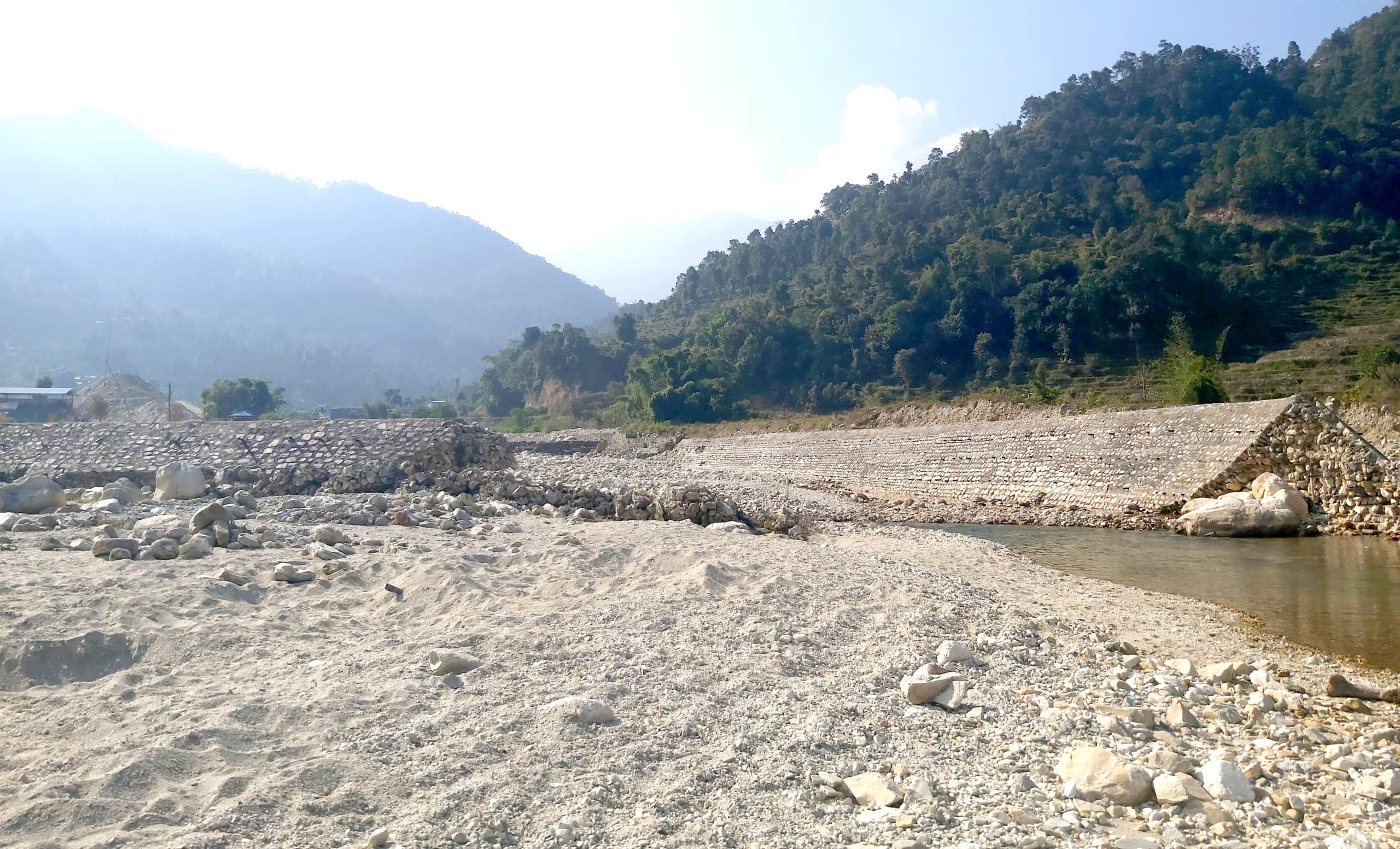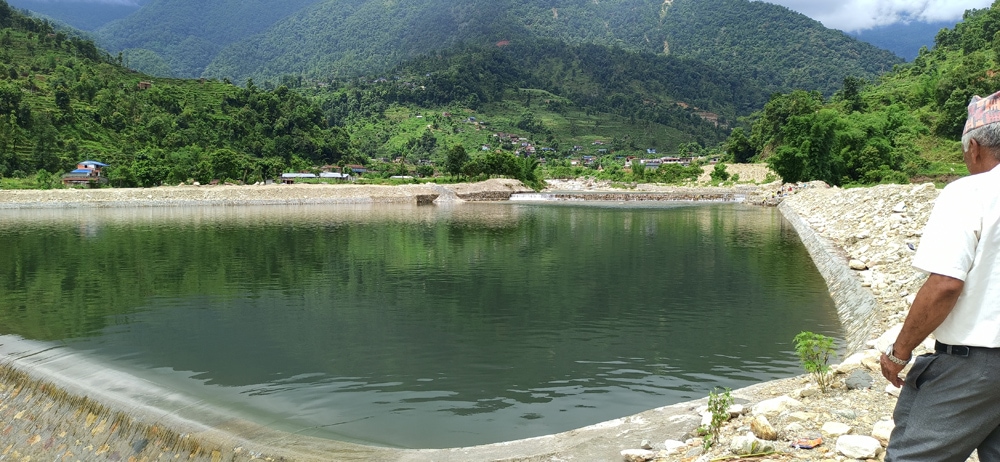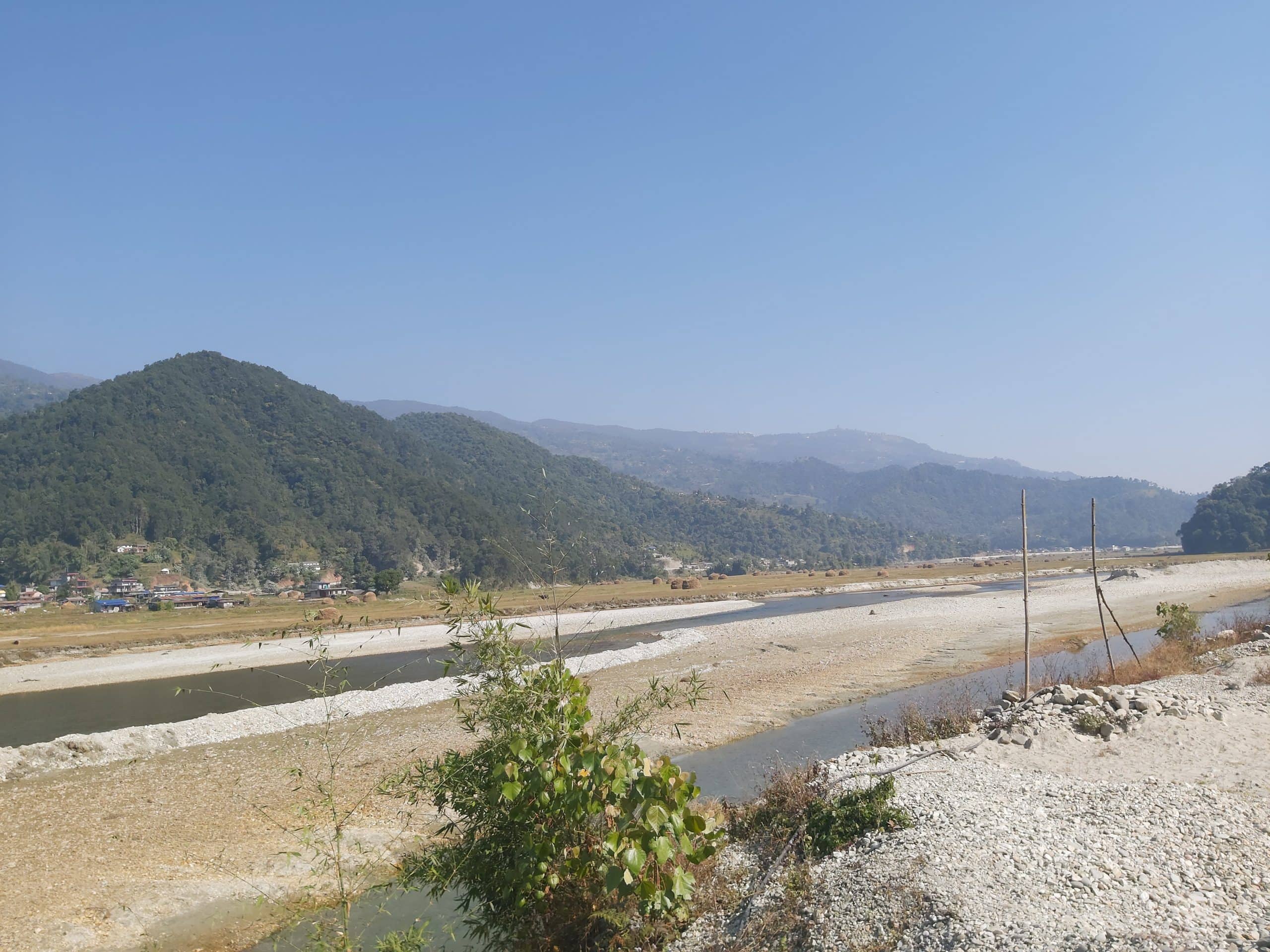A major dam constructed to stop silt deposition in Fewa lake faced damage due to substandard construction. The remaining three dams are also at risk of collapse. Rs 280 million budget spent for constriction went in vain but no one has been held accountable so far for this loss.
Shyam Rana Magar | CIJ, Nepal
In the second week of June, the Harpan dam constructed at the entrance gate of Fewa Lake, a center of attraction in the tourist destination, Pokhara popularly known as lake city, suffered major damage. Harpan, Khahare, Lauruk and Betayani are four key sources that bring in water into Fewa lake.
Along with water, boulders, sand and debris also deposited in the lake. The deposition is reducing the actual size of the lake each year. To stop the flow of silt coming into the lake from streams Gandaki Province government and Pokhara Metropolitan City jointly formulated a policy to construct siltation dams above the lake. About Rs 280 million was released to construct ponds and dams in Harpan Khola, Khahare Khola, Lauruk Khola and Betayani Khola as suggested in the policy document. But an early monsoon rain and flood damaged the Harpan dam shortly after its construction. Due to substandard construction remaining three dams are also at high risk of damage.

google Earth
A CIJ investigation finds Harpan dam did not collapse due to natural disaster. After analyzing interviews done with locals protesting against the substandard dam construction, construction experts and researches carried out by the government after the damage it can be concluded that the dam collapsed because of the wrong construction site and wrong design. This kind of negligence has not only caused the loss of state coffers but also posed a greater risk to local settlements and the future prospects of the lake in the long run.
According to a report prepared by the Government of Nepal in collaboration with Finish International Development Agency 142,000 metric tons of boulder, soil and sediments are deposited in Fewa Lake from upstream areas annually. Those dams were constructed like the size of the lake continued to shrink each year because of increased silt deposition.
But sub-standard construction has caused yet another problem. Bishnu Prasad Parajuli, ward chief of Pokhara Metropolitan City-23, says downstream areas are damaged after the first flood in the rainy season destroyed the Harpan dam.
“Paddy planted in several hectares of land was destroyed and houses in the surrounding areas are at high risk of damage,” Parajuli says, “Locals were left in the dark when the construction started. We protested against substandard construction but our voices were simply ignored and unheard.”
Harpan dam damaged in early monsoon flood
Of the total four dams constructed above Fewa lake Harpan dam, which was constructed at a cost of Rs 78.8 million, collapsed in mid-June as it couldn’t stop water pressure. In the aftermath of destruction, the Gandaki Province government and Pokhara Metropolitan City are facing widespread criticism. Locals and elected people’s representatives have raised their voices against substandard construction but their genuine concerns were ignored instead of responding to them.
A week later, the dam collapsed.

Harpan dam
“Nobody listened to us when we raised our voice against the mismatching ratio of cement and sand,” says Bharat Raj Poudel, chief of ward no 23 of Pokhara Metropolitan City adding, “Dam collapsed shortly after our protests.”
In the aftermath of destruction ward chief Parajuli, member Poudel and provincial assembly member Rajiv Pahari have demanded that those involved in faulty dam construction be booked. Under widespread criticism, a committee formed by the provincial government has published a report entitled “Fewa Siltation Dam Problem and Ways of Risk Minimization”. The report prepared by the Policy and Planning Commission of Gandaki Province concludes construction quality of dams was largely compromised.
As stated in the report, the left side of the dam is not strong enough to stop the high pressure of water coming from the steep slope. Other technical lapses were also found in the building wall of the dam.
An engineer privy to dam construction says now a meter-tall support wall needs to be constructed. The engineer suggested routinely measuring the level of flood, constructing another dam to determine the surface of floods a few meters down from the dam and removing sediments from the dam should be done. The aforementioned measures were not taken while constructing the Harpan dam.
Kisan Singh Gurung, a geological engineer, says faulty construction was responsible for the collapse of the dam. “There’s no concrete jacketing. Since there’s no cut-off wall water pressure gradually swept away downstream area,” Gurung adds, “There should have been a stilling basin in place right after the cut-off wall which could lower water pressure. The dam was further weakened in the absence of those infrastructures.”
Khahare dam—at high risk
Among four dams Khahare dam was constructed in Dharapani. The dam constructed by Khadka Krishna PK JV Dang wherein 90.6 million was spent is also now at high risk of damage. The study done after sudden damage of Harpan shows Khahare dam is also not free from risk of damage due to the wrong selection of construction site. As stated in the report, Fewa Siltation Dam Problem and Ways of Risk Minimization, Khahare dam is at high risk of damage as it is also constructed at the point where the water pressure of the stream is high.

Siltation Dam
The report shows the urgency of studying the surface of the stream was overlooked before constructing the dam. It has been suggested the dam could be stronger if a one-meter support wall was constructed towards the right side of the river instead of the left side. Also, it has suggested constructing a dam at least one kilometer up from the Dharapani where the existing dam is.
A member of the study team says only the outer face of the stone wall was cemented. He says a concrete wall should be constructed at the bottom of the dam so that flow of water wouldn’t weaken its base. Check dams are required to stop the flow of silt.
Geological engineer Gurung says checking dams are essential to minimize water pressure to the dams. “If check dams are constructed larger portions of sediments could remain in upstream areas and there remains always low water pressure to the dam,” says study team coordinator Baral, “But the same wasn’t found applied while constructing dams.”
Betayani and Lauruk dams were constructed without a map
Betayani and Lauruk dams are smaller as compared to two other dams. But experts say these dams are also at high risk of collapse due to unmatched slope. Bimal Acharya, an engineer at Pokhara Metropolitan City, construction of these two dams was started based on simple drawings—instead of having separate complete maps.
The government has allocated Rs 54.06 million to Shree Gita Jaya Nepal JV Syangja to construct the Betayani dam whereas Khadka Krishna PK JV Dang was awarded to construct the Lauruk dam. Rs 57.04 million was spent to construct the Lauruk dam. Due to substandard construction, engineers have suggested retrofitting both the dams before the next monsoon starts. The Metropolitans City, however, hasn’t started retrofitting works yet citing a lack of resources.
“The construction company is asked to reconstruct Harpan dam,” says Bharat Raj Poudel, information officer of the Metropolitan City adding, “But the metropolitan city hasn’t taken any decision about retrofitting remaining dams which are said to be at risk.”
The remaining three dams will also reach Fewa Lake if dams are not retrofitted before the monsoon begins.
Prakash Bishwokarma, the proprietor of Khadka Krishna PK JV, the construction company responsible for constructing Harpan, Khahare and Lauruk streams, claimed his company didn’t work after the contract expired. He says the dam collapsed after massive sediments flooded from slope areas. Even as the metropolitan city has asked the construction company to reconstruct dams, actual work hasn’t started.

Khim Prakash Malla, the proprietor of Gita Jaya Nepal Ishwor JV, the company awarded for constructing Betayani dam, also claimed that dams were constructed as per contract. Technicians involved in study teams, however, say the dams were constructed in the wrong places by using substandard construction materials. It seems the metropolitan city handed over the certificate of project completion without monitoring. Dhan Bahadur Nepali, the spokesperson for Pokhara Metropolitan City, says instruction given to the company in writing for reconstruction is the best thing they did.
A complaint has been filed at the regional office of the Commission for Investigation of Abuse of Authority, the anti-corruption agency, on charge of financial irregularities and the use of substandard construction materials while constructing dams. Also, a Public Interest Litigation has been filed at the High Court demanding to hold those involved in dam construction.
Megh Nath Rijal, information officer at the anti-corruption agency, says the investigation into faulty dam construction is underway. Manju Devi Gurung, Chief Executive Officer of Pokhara Municipality, says reconstruction of the siltation dam has already started.
The study team has concluded that it will cost at least Rs 270 million for retrofitting three dams whereas the total construction expenses incurred for four dams was Rs 280.96 million.
Income from sediment: an ‘immature’ plan
Gandaki Province and Pokhara Metropolitan City aim to stop sediments and sell them in the market to make money. The report prepared by the metropolitan city estimates 90,000 cubic meter sediments will be collected from Harpan, 135000 cubic meters from Khahare, 24000 cubic meters from Lauruk and 16000 cubic meters from Betayani. Arguing that active landslides are noticed up streams of the lake, the report states more sediments could collect than the estimated. With this calculation, the metropolitan city has awarded Fewa Siltation P. Ltd. To manage the sediments depositing above Fewa Lake.
In return, the metropolitan city will get Rs 26 million from the private firm. The feasibility study has shown that Rs 207.1 million incomes could be generated from siltation sell.
Even as the private firm was awarded for extracting sediments at the cheapest quote entrance gate required for extracting sediment has not been constructed. In case of floods, the emergency exit system has not yet been arranged.
Engineer Kisan Singh Gurung says the problem has aroused as no plan is in place in extracting sediments deposited at the dam site. “Sediments will keep depositing at the dam. It causes problems if deposited sediment is not extracted in time. Risk of dam damage remains high,” he says.



